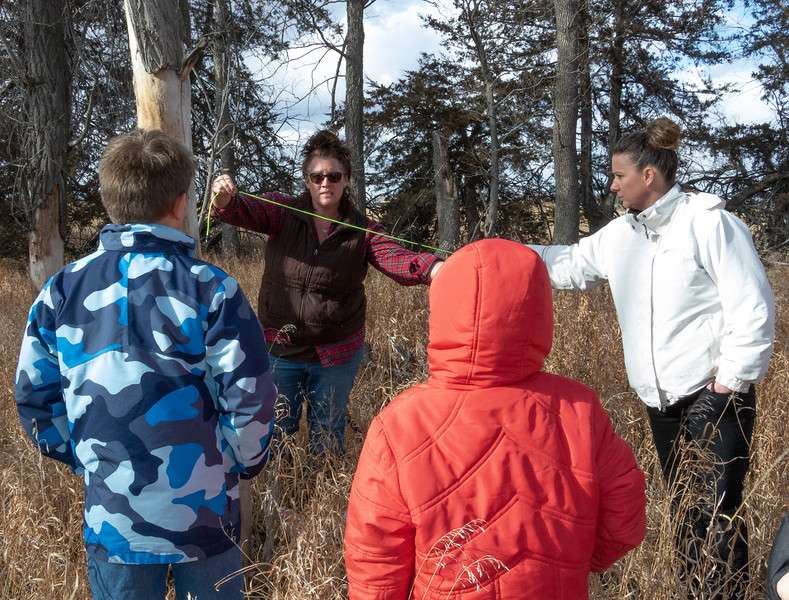By TENA L. COOK, Marketing Coordinator
CHADRON – Chadron State College students, a CSC alumna, and elementary students joined hundreds of other volunteers collaborating with a University of Nebraska Omaha (UNO) and Nebraska Game and Parks Commission (NGPC) community science project this spring.

The purpose of the project is to determine if spotted skunks remain in Nebraska since the last known sighting of the species occurred in 2017. More than 600 volunteers are assisting to determine if any populations are left, and if so, where they are located, and what habitat they prefer.
Dr. Teresa Frink, professor of Agriculture and Range Management, contacted UNO graduate student, April Sperfslage, who is overseeing the project and was able to involve 39 CSC students and Hay Springs Higher Ability Learners (HAL) in the spotted skunk survey.
The CSC students worked in small teams to place 20 trail cameras with bait stations a specified distance from the cameras in an effort to document the presence of spotted skunks.
CSC alumna Crystal Vander May, HAL leader at Hay Springs, and her students participated by placing a camera on Frink’s land, south of Hay Springs.
CSC students Sage McGinnis, Hayden McGinnis, Brolin Morgan, and Morgan Fawver, participated in the project from mid-March until early May. Sage McGinnis and Hayden McGinnis of Buena Vista, Colorado, who are siblings, worked in a team with fellow CSC student Emma Pendleton of Hemingford, Nebraska.
Sage McGinnis said working with UNO and the NGPC was a rewarding experience and the process allowed her to have an increased understanding of the complexity of a study of wildlife populations.
“It is satisfying to work on a project that will be utilized outside of the school setting. Moving forward in our individual careers, it will be extremely beneficial to have this experience and knowledge about how to collaborate with various organizations working towards a common goal,” Sage McGinnis said.
Hayden McGinnnis said he gained important insights from conducting hands-on research.
“A lot can be learned in the classroom, but often the most beneficial experience comes in the field. It was fun to go out and set the camera traps following various protocols and methodologies relating to the study. Overall, it was very interesting to participate in and witness how the research process works in the field,” he said.
Hayden McGinnis said his team placed its camera southeast of Crawford near some abandoned buildings and a seasonal wetland. Many images were tumbleweeds and grass blowing in the wind, some were of cats, raccoons, deer, robins, and doves, but none were spotted skunks.
“It was a challenge to keep the vegetation clipped enough so that when the wind blew the camera would not be tripped by the blowing vegetation. With each camera check we had to modify it a little bit to minimize these impacts,” Hayden McGinnis said.
Morgan and her research partner, Fawver, both of McCook, Nebraska, placed their camera on land by Maxwell, Nebraska, near the Platte River.
The two refreshed the bait over several weeks, and the camera captured photos of white-tailed deer, common raccoon, and Virginia opossums, although no spotted skunks, according to Morgan.
Vander May said starting the project with her HAL students triggered a flood of questions and resulted in them researching more about the species and possible reasons for a declining population including reproduction, food supply, environmental changes, and predators.
Vander May said she and the HAL students measured the trees’ distance and height in order to find a suitable location for luring a spotted skunk. The Frink family updated the bait and checked on the camera.
“Our prediction of the spotted skunk being rare was confirmed when we had no sightings of them on our trail camera. However, we were able to access a website with more trail camera photos of animals that others had caught on their trail cameras, including a spotted skunk,” Vander May said.
Shaun Dunn, Natural Heritage Zoologist and Certified Wildlife Biologist with the NGPC, said partners like CSC and Hay Springs are valuable in gathering data and photos.
“This has allowed us to expand our efforts across the state and include some really needed data to the project,” Dunn said.
Sperfslage said students bring the additional benefit of being familiar with field sites that professional researchers may not be able to access due to lack of time or knowledge of suitable habitat.
“These students have the drive and enthusiasm to contribute to real science,” Sperfslage said. “It's difficult for just a few researchers to gather data on our own, especially if we're interested in determining where populations of spotted skunks may remain across the entire state of Nebraska.”
Involving elementary school children is an additional positive aspect of the project, according to Dunn and Sperfslage.
“It’s a great thing for the kids to be able to say, ‘I helped with that,’” Dunn said.
Sperfslage said exposing young children to wildlife research can shed light on the work.
“My hope is even if children don't fall in love with the field of wildlife research, that through community science projects they will gain respect for wildlife, the environment, and understand the importance of science,” Sperfslage said.
Anyone interested in participating in the long-term community science project may sign up online until spring 2023 http://outdoornebraska.gov/spottedskunk/ or contact Dunn or Sperfslage.



